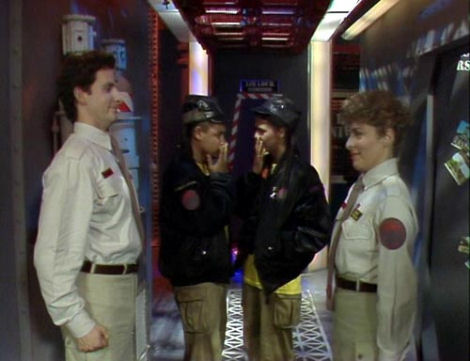
-Back cover of Red Dwarf Series II DVD
Red Dwarf's underlying plot remained relatively constant throughout the run of the show: Dave Lister, the last human being in the universe (presumably), is 3,000,000 years from Earth, trapped in the abyss of deep space inside the mining vessel Red Dwarf and is trying to desperately to get back to Earth. The story behind the plot is an interesting one; the rest of the crew have been killed by a radiation leak accidentally caused by Arnold Rimmer, Lister's bunkmate and fellow technician. Lister was spared a painful death because he had been put into stasis (suspended animation) before the accident. He was placed in stasis because the ship's computer, Holly, had detected a non-human life form in Lister's room. Despite Lister's insistence that the non-human life form was merely Rimmer, the captain discovered that Lister had been hiding an unquarantined cat in his room. Instead of forfeiting the cat, Lister decides to take the punishment of forfeiting eighteen months pay and goes into stasis. While he is in stasis, the drive plate breaks open and the whole crew is exposed to a lethal dose of cadmium-2 ("The End"). Lister is revived by Holly 3,000,000 years later once the radiation had reached a safe level.
Lister is alone, save for a few companions that were spared the calamity in one way or another; Rimmer, his hologramtic roommate who is obsessed with rules and regulations; The Cat, a member of the Cat race Felis Sapiens that evolved from Lister's cat sealed 3,000,000 years ago in the ship's hold; Kryten, a Series 4000 mechanoid that has broken his programming, but still enjoys cleaning and doing selfess acts for the crew; and Holly; the ships computer whose brilliant mind has fallen prey to computer senility over the eons of lonlieness (for a more fully fleshed-out summary of the character profiles, visit it "Characters" page).
From the beginning of the series, however, the main plot is overridden by the "situational" comedy that is a staple of sitcoms. Even within the first series (the British equivalent of a TV season) the plan for returning to Earth is only mentioned in the first of six episodes, "The End". Instead, episodes take advantage of Lister's confusion upon waking 3,000,000 years in the future. For instance, the episode "Waiting for God" reveals that the Cat people have taken the idea of Lister as their god. According to the holy texts of the Cat people,
"Legend has it that Cloister was frozen in time to save Frankenstein, the Holy Mother of the cat-people. He would eventually return and lead the cat-people to Fushal... the Promised Land. This is actually their interpretation of Lister's plan to open a hotdog and donut diner stand on Fiji, but three million years of retelling the tale warped the names and events beyond recognition. ("Cat Religion in Red Dwarf")
As one can see, the show started off relatively early making a name for itself with original plot lines and interesting character development. Lister was the god of the Cat race and last human alive, Rimmer ended up dealing with a hologramatic doppleganger, and the Cat ended up being the last of his people all within the first series.

In the second series, it seems that, instead of trying to get home, the Dwarfers are more concerned with finding a means of enjoying their almost certain exile into the abyss of deep space. Episodes like "Better than Life", wherein the Dwarfers find an artificial reality (AR) computer game that allows them to live out all their fantasies, and "Parallel Universe", where the crew members meet alternative versions of themselves from an alternate Red Dwarf (see iamge at right), show the importance of situational comedy to the development of the show. These early episodes of fantasy helped to bring in an audience that had diminished by two million viewers after the first series (red dwarf programme guide).
From the third series all the way until the end of the show in the eighth series, the dwarfers are even less focused on finding their way back to Earth. Instead, the series becomes a series of "fight-for-survival" stories that depict the characters trying to survive in their new home in deep space. From this point on, the show becomes one novum after another, with everything from the a rogue Genetically Engineered Life Form (GELF) attacking the crew to Kryten being turned into a human after the crew finds a DNA modifier to the discovery of an entire planet made of wax replicas of all the greatest heroes and villains of all time. This is not to say that series becomes unenjoyable after this point; on the contrary, Red Dwarf experienced an extreme increase in popularity after the third series and went on to win an International Emmy Award in the Popular Arts category (Red Dwarf Programme guide).
The Dwarfers go through a multitude of trials and tribulations during their travels. Despite being attacked by a suicidal-thought-inducing cephalopod, having themselves wiped from existence by future versions of themselves, and Listers having to marry a particularly hideous GELF "who's name sounds like a footballer clearing his nose", the Dwarfers eventually manage to resurrect the whole crew of Red Dwarf (through the use of some helpful nanobots) and begin their journey back home.
Last update: 11/23/2009
This site was created by Stephen Shapiro for HONR101, Speculative Visions, an honors course at DePauw University in Greencastle, Indiana, instructed by Dr. Arthur Evans. If you have any questions or comments about the website, please contact: stephenshapiro_2013@depauw.edu